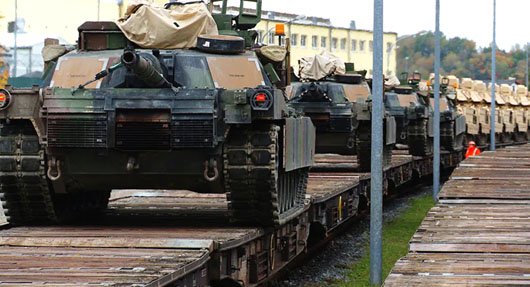FPI / February 4, 2020
Though U.S. President Donald Trump has criticized European countries for not contributing enough to NATO’s budget, in the Spring of 2020 the United States will signal its resolve to defend its NATO allies by deploying the largest number of troops to Europe since the Cold War.
Resembling the NATO REFORGER exercises before the fall of the Berlin Wall, the U.S. Army will send a division headquarters, three tank brigades and scores of other troops, totaling 20,000 American soldiers, to Europe for what will be the largest American-led war game on the continent in 25 years.

Elements from the U.S. Air Force and Marine Corps will also participate. The war games, named Defender Europe, will see U.S. equipment arriving in Europe this month and the exercises being held in April and May.
According to Reuters, U.S. Maj. Gen. Barre Seguin at Supreme Headquarters Allied Powers Europe said the exercises, centered in Germany and Poland, will underscore the U.S. commitment to NATO. As part of the exercises, the U.S. Army will assess its preparedness to move soldiers overseas to the Netherlands and Belgium and then east through Germany and Poland. After joining thousands of U.S. personnel stationed throughout Europe and 18 other NATO allies’ military forces constituting around 37,000 troops in all, the U.S. forces will return to the U.S.
“We have not demonstrated this ability to rapidly reinforce, from a transatlantic perspective … for 25 years or so,” Seguin told reporters.
“Readiness is not only about having the right forces and capabilities in place throughout the theater, it’s about exercising our ability to quickly receive and integrate forces with our own and those of our allies and partners,” Lt. Gen. Christopher Cavoli, U.S. Army Europe commanding general, said in a statement reported by Stars and Stripes. “This ability is critical in projecting force at a moment’s notice.”
Russian officials have condemned the planned maneuvers. According to the UK Express, Russian Foreign Ministry spokeswoman Maria Zakharova said the alliance was now looking to expand beyond its geographical zone of responsibility. She condemned NATO leaders for focusing on what she described as the “the made-up Russian threat” while turning a blind eye to other regions of the world. Zakharova said this only added to a growing number of questionable positions taken by NATO as it continued to place expanding defense capabilities to deter Russia at the top of its “dangerous” agenda.
However, as reported by Euronews, NATO Secretary General Jens Stoltenberg said the large-scale exercises were a reminder of the strength of the alliance. Stoltenberg added that while much of the training will take place along parts of the Russian border, the military build-up was not about targeting Russia.
“Our allies Lithuania, Estonia, and Latvia are marking the 30th anniversary of their freedom. They made the sovereign choice to join NATO and, at their invitation, some of the exercise activity will be held on their territory. Russia has every right to feel secure within its borders, but so do our member states.”
“We do not seek confrontation with Russia, but the fact is that Russia’s recent activities have reduced stability and security, increased unpredictability, and changed the security environment,” Stoltenberg said.
Analysts say the new security environment is why this exercise — while similar in concept — only partly resembles war games from the Cold War. For one, the front lines have moved westward by hundreds of miles into Central Europe, as opposed to Germany where the U.S. enjoyed robust and properly oriented infrastructure in the 1980s. Then there is the problem of holding open the sea and air lines of communication, as well as protecting the ports of arrival that would receive allied troops. The Russians are now able to contest the Baltic Sea and airspace over Central Europe.
Retired Army Lt. Col. James Jay Carafano argues in the Association of the U.S. Army (AUSA) website: “In analyzing what the exercise portends for the future of America’s Army, many will want to make comparisons with REFORGER…That would be a mistake. The geopolitics have changed. The nature of potential regional conflict has changed. The size of America’s footprint has changed. Defender-Europe signals the need for a different kind of Army — not just a replay of Cold War thinking.”
Carafano concludes, “Defender-Europe is a good start in the right direction — but there is much, much more to be done.”
Intelligence Brief __________ Replace The Media
